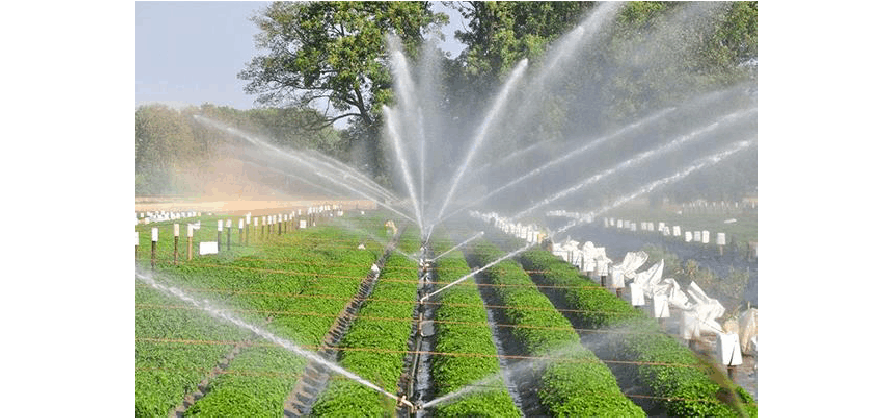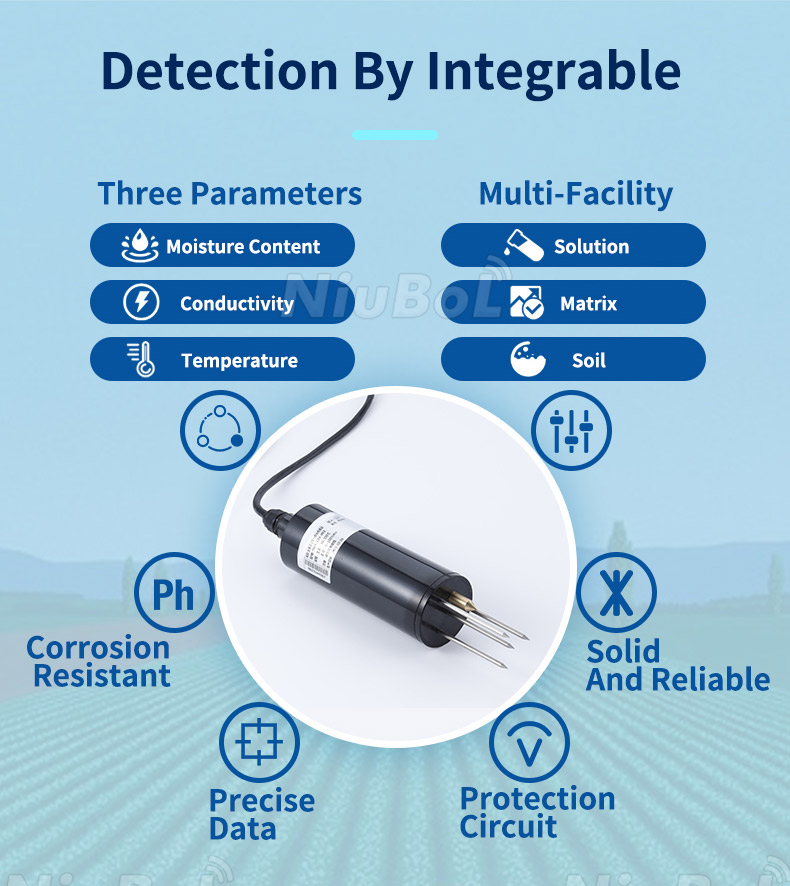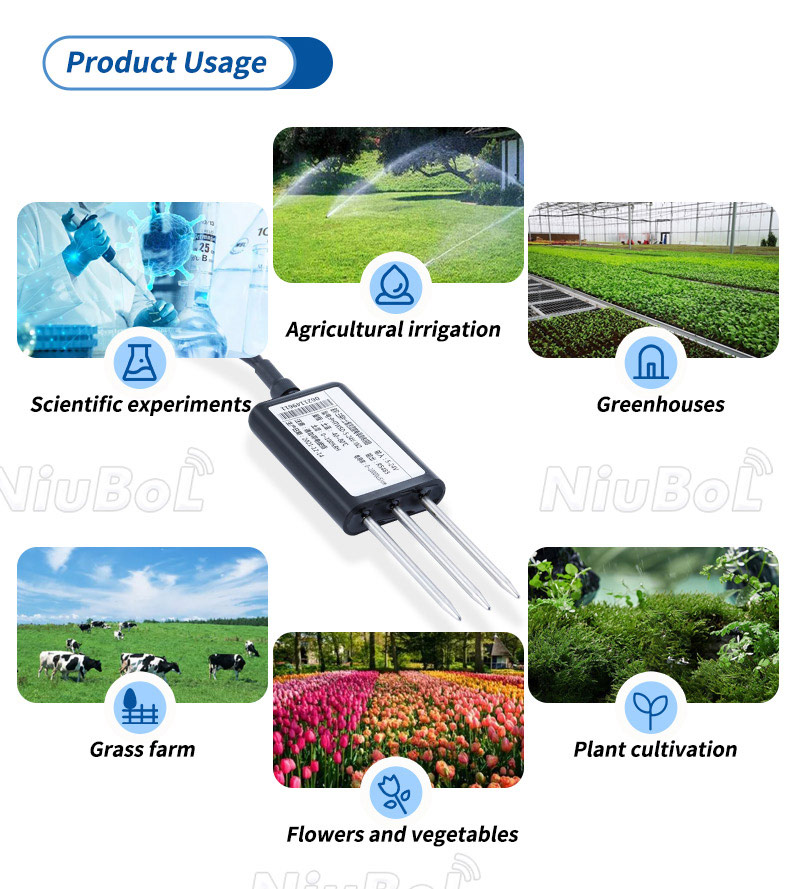

— Blogs —
—Products—
 Consumer hotline +8618073152920
Consumer hotline +8618073152920 WhatsApp:+8615367865107
Address:Room 102, District D, Houhu Industrial Park, Yuelu District, Changsha City, Hunan Province, China
Product knowledge
Time:2024-10-24 16:10:46 Popularity:1232
Irrigation soil moisture sensor, also known as soil moisture meter, soil moisture meter, soil moisture meter or soil moisture sensor, is a kind of high-precision and high-sensitivity instrument specially used for measuring soil moisture content. It can reflect the moisture condition in the soil in real time and accurately, and provide scientific basis for farmland irrigation.

1. High-precision measurement: using advanced sensing technology, it can measure the moisture content in the soil with high precision.
2. real-time: real-time transmission of data, so that farmers can keep abreast of the soil moisture status.
3. Stability: good stability, able to work for a long time under various environmental conditions.
4. Ease of use: simple installation, operation and maintenance, farmers can easily get started.
5. Corrosion resistance and sealing: stainless steel probe and epoxy resin encapsulation, suitable for long-term buried in the soil, free from corrosion.
6. Low power consumption: suitable for long time working in the field, some models support solar power supply.
7. Multiple output modes: support voltage type and current type signal output, as well as RS485 communication protocol, convenient to integrate with control system.
8. Interchangeability and easy installation: compact and lightweight design, easy to carry and install, reduce maintenance costs.
9. Adaptable: less impact on different soil types, applicable to a wide range of geographical areas and soil types.
Irrigation soil moisture sensor has a high value in agricultural production. It can help farmers accurately grasp the soil moisture status, so as to develop a reasonable irrigation plan, improve irrigation efficiency and accuracy, avoid water waste and environmental pollution. At the same time, it can also improve crop yield and quality, bringing greater economic benefits for farmers.
Irrigation soil moisture sensor application scenarios are very wide, including but not limited to:
1. Agricultural irrigation management: through real-time monitoring of soil moisture content, to help the irrigation system to accurately control the time and amount of irrigation water, to maintain soil moisture in the appropriate range.
2. Greenhouse control: In greenhouses, sensors can monitor soil moisture conditions and help farmers control the temperature and humidity in the greenhouse to create the most suitable growing environment for crops.

3. Forestry and garden management: Protect the health of vegetation in forests and parks by monitoring soil moisture levels in real time and making timely adjustments to irrigation and water management.
4. Grassland pasture: Monitor grassland soil moisture to optimise grazing management and improve grassland productivity and livestock health.
5. Drought relief: In drought relief work, the sensor can quickly and accurately provide soil moisture data to help the relevant departments formulate scientific drought relief programmes.
6. Golf courses and gardens: to maintain the beauty and health of lawns and green spaces.
7. Scientific research and teaching: for soil research, plant physiology experiments, and teaching demonstration of agricultural technology.
8. Environmental monitoring and protection: to assess the water balance of ecosystems and guide ecological restoration.

1. Improve irrigation efficiency: the sensor can accurately measure the soil moisture content to help farmers develop a reasonable irrigation plan to avoid over-irrigation or under-irrigation.
2. Save water: By precisely controlling the amount of irrigation, the sensors help to reduce the waste of water.
3. Improve crop yield and quality: Proper soil moisture is one of the key factors for crop growth. Sensors can help farmers to provide the best growing environment for crops, thus improving crop yield and quality.
4. Reduce the occurrence of pests and diseases: appropriate soil moisture helps to reduce the occurrence of pests and diseases, reduce the use of pesticides and improve the safety of agricultural products.
5. Optimise fertiliser application: moisture conditions affect the dissolution and absorption of fertilisers, and rational irrigation helps to improve fertiliser utilisation efficiency.
6. Environmentally friendly: reduce unnecessary irrigation, reduce the excessive exploitation of groundwater, in favour of environmental protection.
The measurement principle of irrigation soil moisture sensor is mainly based on the following techniques:
1. Dielectric constant principle: soil moisture content is inferred by measuring the change in soil dielectric constant, since the dielectric constant of water is much larger than that of soil solids.
2. Frequency domain reflection principle (FDR): by sending electromagnetic waves into the soil, the dielectric constant of the soil is calculated based on the difference in propagation speeds of the electromagnetic waves in media with different dielectric constants, and the moisture content of the soil is then deduced.
3. Time Domain Reflection (TDR): Calculate the dielectric constant of the soil by measuring the propagation time of the electromagnetic wave in the soil, and then deduce the moisture content.

Irrigation soil moisture sensors are applicable to a variety of agricultural fields, including but not limited to:
1. Precision agriculture: for data-driven agricultural production management.
2. water-saving irrigation: to optimise irrigation schedules and reduce water waste.
3. Crop growth monitoring: to monitor water requirements during the crop growth cycle.
4. Field Crops: Monitor water status of field crops such as wheat, corn, and soybeans.
5. Orchards and vineyards: Provide appropriate water for fruit trees and grape vines.
6. Vegetable greenhouses: precisely control soil moisture in greenhouses.
7. Grassland pasture: optimise grazing management and improve grassland productivity and livestock health.
Irrigation soil moisture sensor installation method usually includes the following steps:
1. Select the installation location: according to the actual need to select the appropriate installation location, usually select a representative soil area for installation.
2. Prepare installation tools: Prepare the required installation tools, such as screwdrivers, drills and so on.
3. Install the sensor:
- Vertical insertion method: Insert the sensor vertically into the soil, keep it at 90 degrees and avoid shaking to protect the probe. Suitable for single point measurement.
- Parallel arrangement method: multiple sensors are inserted parallel to each other for multi-layer or large area soil moisture monitoring, keeping a certain distance to avoid interference.
- Direct burial method: Choose a suitable measurement point, usually near crop roots, dig a small pit in the soil, place the sensor horizontally in the pit, gently fill back in the soil, make sure the sensor is in close contact with the soil, connect the sensor's cable to the data collector or controller.
4. Commissioning and calibration: After installation, commission and calibrate the sensor to ensure the accuracy of the measured data.
5. Regular inspection and maintenance: inspect and maintain the sensor regularly to ensure its long-term stable operation.
Summary
Irrigation soil moisture sensor has a high application value in agricultural production. By accurately measuring soil moisture content, it can help farmers develop rational irrigation schedules, improve irrigation efficiency and crop yields, while conserving water resources and reducing environmental pollution. The use of these sensors, combined with modern information technology, such as the Internet of Things and big data analysis, has become an indispensable part of modern agriculture, promoting the development of agriculture in the direction of intelligence and efficiency.
1.NBL-S-THR Soil Temperature Moisture Sensor datasheet
NBL-S-THR-Soil-temperature-and-moisture-sensors-Instruction-Manual-V4.0.pdf
2. NBL-S-TMC Soil Temperature Moisture EC Sensor datasheet
NBL-S-TMC-Soil-temperature-and-moisture-conductivity-sensor.pdf
3. NBL-S-TM Soil Temperature Moisture Sensor datasheet
NBL-S-TM-Soil-temperature-and-moisture-sensor-Instruction-Manual-4.0.pdf
4. NBL-S-TMCS Soil Temperature, Moisture, Conductivity and Salinity Integrated Sensor
NBL-S-TMCS-Soil-Temperature-Humidity-Conductivity-and-Salinity-Sensor.pdf
5. NBL-S-TMCS-7 Soil Temperature, Moisture, NPK, Conductivity and pH Integrated Sensor
7-in-1-Soil-Composite-Sensor-Manual.pdf
4. NBL-S-TMCS-8 Soil Temperature, Moisture, NPK, pH, Conductivity and Salinity Integrated Sensor
Related recommendations
Sensors & Weather Stations Catalog
Agriculture Sensors and Weather Stations Catalog-NiuBoL.pdf
Weather Stations Catalog-NiuBoL.pdf
Related products
 Combined air temperature and relative humidity sensor
Combined air temperature and relative humidity sensor Soil Moisture Temperature sensor for irrigation
Soil Moisture Temperature sensor for irrigation Soil pH sensor RS485 soil Testing instrument soil ph meter for agriculture
Soil pH sensor RS485 soil Testing instrument soil ph meter for agriculture Wind Speed sensor Output Modbus/RS485/Analog/0-5V/4-20mA
Wind Speed sensor Output Modbus/RS485/Analog/0-5V/4-20mA Tipping bucket rain gauge for weather monitoring auto rainfall sensor RS485/Outdoor/stainless steel
Tipping bucket rain gauge for weather monitoring auto rainfall sensor RS485/Outdoor/stainless steel Pyranometer Solar Radiation Sensor 4-20mA/RS485
Pyranometer Solar Radiation Sensor 4-20mA/RS485
Screenshot, WhatsApp to identify the QR code
WhatsApp number:+8615367865107
(Click on WhatsApp to copy and add friends)
